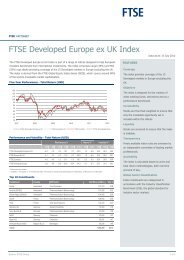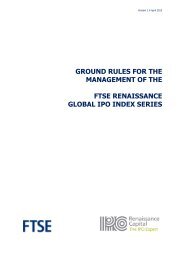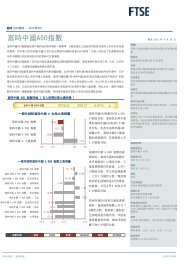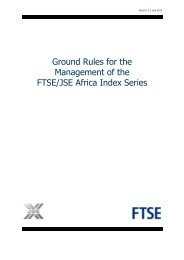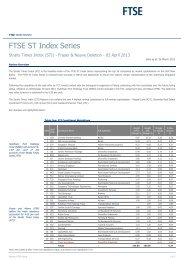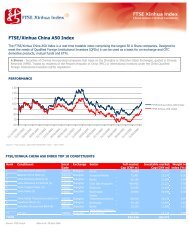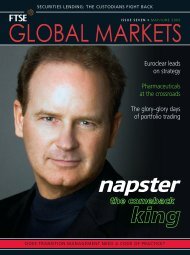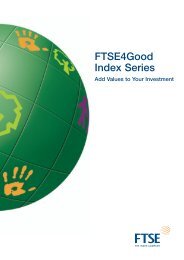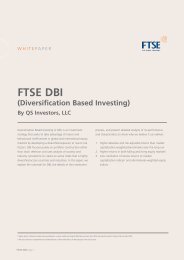Create successful ePaper yourself
Turn your PDF publications into a flip-book with our unique Google optimized e-Paper software.
a more sombre cast (well before 9/11 in fact). The<br />
competitive game in which the CME was playing was in<br />
flux. Competition between futures exchanges intensified<br />
and the stage became global, rather than national or<br />
regional. Although liberalising legislation via the<br />
Commodity Futures Modernization Act of 2000 (CFMA),<br />
had given the CME added impetus with which to face the<br />
future, advances in technology and a more favourable<br />
regulatory environment simultaneously encouraged<br />
European exchanges – namely Euronext.liffe and Eurex – to<br />
mount a competitive charge on the benchmark products of<br />
the US futures market.<br />
The CME found that it faced a clear and present<br />
danger, perhaps for the first time. The specialist<br />
derivatives media added to the pressure. Chicago’s<br />
exchanges were simply not up to growing competition<br />
from abroad, they said and CME would be forced to cut<br />
trading fees to non-economic rates to encourage more<br />
volume, or that its mix of users would change and alter<br />
its profitability. Ironically, all that did happen, but not<br />
quite in the way the doubters expected.<br />
The CME realised it needed to overhaul not only its<br />
business structure and strategy, but also its international<br />
ambitions. Its response was rapid, accelerating changes<br />
that were already in motion, such as migration to<br />
electronic trading and a reduction in trading costs. “We<br />
always thought about competition in terms of three major<br />
industry trends: deregulation, rapid advances in<br />
technology, and globalisation of intermediaries and<br />
customers,” explains Donohue. “We built the financial<br />
strength and critical mass necessary for executing our<br />
long-range strategy of expanding our core business,<br />
broadening our product range, providing third-party<br />
transaction services and exploring new business<br />
opportunities and that process continues.”<br />
Investment in technology was intensified, as a priority.<br />
”We spend more on technology today than was our entire<br />
operating budget five years ago,”says Donohue.“In the last<br />
8 years we have invested over $1bn in technology and gone<br />
from having 125 or so technology specialists five years ago<br />
to employing around 450 today … the processing<br />
capabilities that we have, the global distribution network,<br />
even the backup and disaster recovery facilities point to us<br />
being more attuned to technology than ever before.”<br />
“Today, we have marketing offices, telecommunications<br />
hubs and customer support capabilities in major financial<br />
centres, including London, Milan, Amsterdam, Frankfurt,<br />
Gibraltar, Paris, Dublin and Singapore,” expands<br />
Donohue. In preparation for that, over the last decade,<br />
CME has developed, enhanced and refined, its electronic<br />
trading platform. “Our order Return Delivery Time is 25<br />
milliseconds, among the fastest in the industry. CME<br />
Globex is also accessible virtually 24 hours a day, longer<br />
than any other electronic platform.” CME had launched<br />
the industry’s first electronic trading platform (or system),<br />
back in 1992. CME Globex revolutionised derivatives<br />
trading by delivering much faster trade execution and<br />
<strong>FTSE</strong> GLOBAL MARKETS • JULY/AUGUST 2005<br />
trading anonymity. It also eliminated CME membership<br />
requirements for traders. Originally based on a DEC<br />
platform developed by Reuters, CME upgraded to its<br />
present multiplatform environment in 1998 – the service<br />
is built on top of a heterogeneous environment of IBM<br />
and Tandem mainframes, Solaris and Linux systems.<br />
Investment in enhancing transaction rates means more<br />
than just faster processing.The company makes money by<br />
charging for executing trades and then charging to settle<br />
those trades. Therefore, the faster its systems are, the<br />
more trades it can handle, and the more profitable the<br />
CME becomes.<br />
Migration to electronic trading has also spurred<br />
efficiency. Late last year the CME estimated that the<br />
average rate per trade (an important profitability measure)<br />
is around 77 cents for CME Globex products, compared with<br />
52 cents for products traded via open outcry.The CME then<br />
simply earned 60% more revenue when a contract is traded<br />
on electronically than on the floor. Electronic trading is<br />
therefore elemental to earnings growth and simultaneously<br />
provides the CME with more room to compete with other<br />
exchanges on fees. As a consequence a number of fee<br />
cutting initiatives have been underway, particularly aimed<br />
at European customers, Asian banks and hedge funds.<br />
There are also other related initiatives. For instance, “we<br />
have expanded the market maker program to nonmembers,<br />
and non-member firms, so that an electronic<br />
proprietary trading group or electronic trading arcade that<br />
would like to meet our market making requirements can<br />
do so at very reduced fees,” acknowledges Donohue.<br />
Recent press reports would have it that around 80% of the<br />
market by transaction volume is trading electronically in<br />
CME Globex Eurodollars for between 14 cents and 18 cents,<br />
compared with prices anywhere between 50 cents and 80<br />
cents on the open outcry floor, because of brokerage costs<br />
and the scale of the trade. Donohue concedes that few, if<br />
any, exchanges can compete at its lower price levels.<br />
Outrageous fortune has not come without its slings and<br />
arrows. Eurex US which to date has not succeeded in<br />
setting up a strong foothold in the North American market<br />
filed a second amended antitrust complaint with an Illinois<br />
District Court against the CBOT and CME in March this<br />
year. Eurex US had also filed an antitrust action against the<br />
two exchanges back in October 2003 for alleged anticompetitive<br />
behaviour. The complaint included allegations<br />
that the CBOT and the CME have violated the Sherman<br />
Act by lowering transaction fees to predatory levels and<br />
allegedly attempting to keep Eurex from obtaining clearing<br />
services. The CME dismisses the charges.<br />
The move nonetheless illustrates Eurex’s frustration over<br />
the difficulties in breaking into the US market, particularly<br />
as it was the first foreign exchange to establish a US<br />
subsidiary and enter into direct head-on competition with<br />
the incumbent exchanges. Eurex has however succeeded in<br />
establishing partnerships with important local institutions.<br />
In its home market, Eurex has been a champion of vertical<br />
integration, but in the US it has railed against the vertical<br />
71



